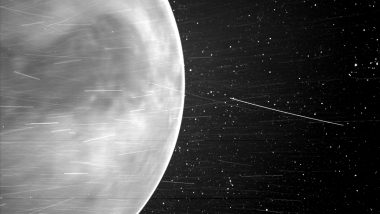2021 has surely been a great start for planetary exposures. With NASA’s Perseverance Rover’s successful landing on Mars, the excitement to explore the other side of the solar system is sky-high. While all the eyes have been on Mars, lately, the eyes of NASA’s Parker Solar Probe were on Venus! The US space agency has shared a gorgeous pic of Venus from an exciting and mysterious flyby, that took place in July, 2020. NASA notes in its blog that Solar Probe’s focus is on the Sun, but the Earth’s ‘sister planet,’ plays a critical role in the mission. It’s a never-seen-before pic, and oh so stunning!
Over the course of its seven-year mission, Parker will make seven flybys, taking advantage of Venus’ gravity to guide the probe’s orbit. While its focus is on the Sun, and studying the solar winds, Parker’s Wide-field Imager (WISPR) is capturing impressive images of the inner solar system along the way. So far, the probe has done four close flybys. And the recent picture shared on social media was taken during its third flyby, last year. The WISPR, captured the striking image of the planet’s nightside from about 7,693 miles away. Life on Venus Possible? Scientists Discover Traces of Phosphine Gas Coming Out of Aerial Microbes in Venusian Atmosphere.
“#ParkerSolarProbe captured this stunning view of Venus during its close flyby of the planet in July 2020. The image shows a bright rim around the planet’s edge, thought to be nightglow, and the dark shape of Aphrodite Terra, a highland on Venus' surface,” NASA captioned the image on Twitter.
Here's the Pic of Venus:
#ParkerSolarProbe captured this stunning view of Venus during its close flyby of the planet in July 2020. The image shows a bright rim around the planet’s edge, thought to be nightglow, and the dark shape of Aphrodite Terra, a highland on Venus' surface. https://t.co/ProKV6S8Hu pic.twitter.com/VEhHcird7M
— NASA Sun & Space (@NASASun) February 24, 2021
Scientists noted that the dark feature prominently seen in the centre of the image is called Aphrodite Terra—the largest highland region on the surface of Venus. The appearance is dark in colour, as the temperature in this region is about 85 degrees Fahrenheit (30 degrees Celsius), cooler than its surroundings. Parker Solar Probe is part of NASA’s Living with a Star program to explore various aspects of the Sun-Earth system that directly affects life and society. The probe has been in space since 2015.
(The above story first appeared on LatestLY on Feb 27, 2021 05:31 PM IST. For more news and updates on politics, world, sports, entertainment and lifestyle, log on to our website latestly.com).













 Quickly
Quickly




















